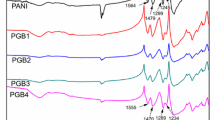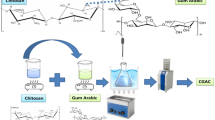Abstract
Recently, interest in developing green polymer coatings which provide self-healing and corrosion protection functions using bio-based renewable materials has significantly increased. In this study, microcapsules containing biopolymers from cashew gum and gum Arabic have been prepared by interfacial polymerization. The prepared microcapsules were individually and combinatorially embedded into epoxy coatings and the resulting composite coatings were then applied on Q235 steel substrates. The performance of the composite coatings was evaluated by immersing both scribed and unscribed coatings in simulated seawater. Surface analytical (SEM), physico-chemical (FTIR, XRD, XPS), and electrochemical impedance spectroscopy (EIS) techniques were used to investigate self-healing and corrosion resistance effectiveness of the polymer composite coatings. The obtained results revealed that cashew gum and gum Arabic could heal the scribed coating surface and subsequently suppressed corrosion reaction, without the aid of any catalyst or co-reactant. The performance was observed to be higher when the two gum exudates were combined. Thus, cashew gum and gum Arabic have demonstrated that they possess properties required for potential utilization in the formulation of marine anticorrosion and self-healing epoxy coatings.









Similar content being viewed by others
References
Arukalam IO, Li Y (2019) Anticorrosion and barrier properties appraisal of poly(dimethylsiloxane)-ZnO nanocoating transition from superhydrophobic to hydrophobic state. J Coat Technol Res 16:1077–1088. https://doi.org/10.1007/s11998-018-00182-2
Cui Y, Qin Y-X, Dilimulati D, Wang Y (2019) The effect of chlorine ion on metal corrosion behavior under the scratch defect of coating. International Journal of Corrosion 2019:1–11. https://doi.org/10.1155/2019/7982893
Li S, Zhang W, Liu J, Hou D-S, Geng Y-J, Chen X, Gao Y, Jin Z, Yin B (2019) Protective mechanism of Silane on concrete upon marine exposure. Coatings 9:558. https://doi.org/10.3390/coatings9090558
Alcántara J, Fuente DDL, Chico B, Simancas J, Díaz I, Morcillo M (2017) Marine atmospheric corrosion of carbon steel: a review. Materials (Basel) 10(4):406. https://doi.org/10.3390/ma10040406
Xiao X-Q, Wang D, Li Y-X, Jackson E, Fang Y, Zhang Y, Xie N, Shi X-M (2016) Investigation into the Synergistic Effect of Nano-sized Materials on the Anti-corrosion Properties of a Waterborne Epoxy Coating. Int. J. Electrochem. Sci 11:6023–6042. https://doi.org/10.20964/2016.07.66
Zheng H-P, Shao Y, Wang Y-Q, Meng G, Liu B (2017) Reinforcing the corrosion protection property of epoxy coating by using graphene oxide–poly(urea–formaldehyde) composites. Corros Sci. https://doi.org/10.1016/j.corsci.2017.04.019
Calabrese L, Proverbio E (2019) A brief overview on the anticorrosion performances of sol-gel zeolite coatings. Coatings. https://doi.org/10.3390/coatings9060409
Yang H, Mo Q-F, Li W-Z, Gu F-M (2019) Preparation and properties of self-healing and self-lubricating epoxy coatings with polyurethane microcapsules containing Bifunctional linseed oil. Polymers 11(10):1578. https://doi.org/10.3390/polym11101578
Karaxi EK, Kartsonakis IA, Charitidis CA (2019) Assessment of self-healing epoxy-based coatings containing microcapsules applied on hot dipped galvanized steel. Front Mater. https://doi.org/10.3389/fmats.2019.00222
Peter A, Obot IB, Sharma SK (2015) Use of natural gums as green corrosion inhibitors: an overview. International Journal of Industrial Chemistry 6(3):153–164. https://doi.org/10.1007/s40090-015-0040-1
Manickam M, Sivakumar D, Thirumalairaj B, Jaganathan M (2016) Corrosion inhibition of mild steel in 1 Mol L−1 HCl using gum exudates of Azadirachta indica. Advances in Physical Chemistry. https://doi.org/10.1155/2016/5987528
Sharma M, Mondal D, Mukesh C, Prasad K (2013) Self-healing guar gum and guar gum-multiwalled carbon nanotubes nanocomposite gels prepared in an ionic liquid. Carbohydr Polym 98(1):1025–1030. https://doi.org/10.1016/j.carbpol.2013.06.074
Mohanty A, Misra M, Drzal LT (2002) Sustainable bio-composites from renewable resources: opportunities and challenges in the green materials world. J Polym Environ 10(1):19–26. https://doi.org/10.1023/A:1021013921916
Ige OO, Umoru LE, Aribo S (2012) Natural Products: A Minefield of Biomaterials. ISRN Materials Science. https://doi.org/10.5402/2012/983062
Ramesan MT, Surya K (2016) Studies on electrical, thermal and corrosion behaviour of cashew tree gum grafted poly(acrylamide). Polymers from Renewable Resources 7(3):81–100
Olorunsola EO, Bhatia PG, Tytler BA, Adikwu MU (2016) Thermochemical properties of hydrophilic polymers from cashew and Khaya exudates and their implications on drug delivery. Journal of Drug Delivery. https://doi.org/10.1155/2016/7496585
Almuslet NA, Hassan EA, Al-Sherbini ASA, Muhgoub MGA (2012) Diode laser (532 nm) induced grafting of polyacrylamide onto gum Arabic. J Phys Sci 23(2):43–53
Bashir M, Haripriya S (2016) Assessment of physical and structural characteristics of almond gum. Int J Biol Macromol 93:476–482. https://doi.org/10.1016/j.ijbiomac.2016.09.009
Verbeken D, Dierckx S, Dewettinck K (2003) Exudate gums: occurrence, production, and applications. Appl Microbiol Biotechnol 63(1):10–21. https://doi.org/10.1007/s00253-003-1354-z
BeMiller JN (2019) Gum Arabic and other exudate gums. Chapter In book: Carbohydrate Chemistry for Food Scientists. https://doi.org/10.1016/B978-0-12-812069-9.00016-9
Ibrahim SM, Abdulkadir A, Muhammed MB (2017) Physicochemical and rheological studies of Irvingia Gabonensis gum exudates as substitute to gum Arabic. Bayero Journal of Pure and Applied Sciences 10(1):658–663. https://doi.org/10.4314/bajopas.v10i1.123S
Thanawala K, Khanna A, Singh RK Development of Self-Healing Coatings Based on Linseed Oil as Autonomous Repairing Agent for Corrosion Resistance. Materials 7(7):7324–7338. https://doi.org/10.3390/ma7117324
Ullah H, Azizli KAM, Man ZB, Ismail MBC, Khan MI (2016) The potential of microencapsulated self-healing materials for microcracks recovery in self-healing composite Systems: A Review. Polymer Reviews. https://doi.org/10.1080/15583724.2015.1107098
Samadzadeh M, Boura SH, Peikari MP (2010) Tung oil: an autonomous repairing agent for self-healing epoxy coatings. Progress in Organic Coatings 70(4). https://doi.org/10.1016/j.porgcoat.2010.08.017
Njoku CN, Arukalam IO, Bai W-C, Li Y (2018) Optimizing maleic anhydride microcapsules size for use in self-healing epoxy-based coatings for corrosion protection of aluminum alloy. Mater Corros 69:1257–1267. https://doi.org/10.1002/maco.201709972
Fink T. Measuring from SEM Micrographs. https://www.ecu.edu/cs-cas/biology/upload/Measuring-from-SEM-Micrographs.pdf
Merline DJ, Vukusic S, Abdala AA (2013) Melamine formaldehyde: curing studies and reaction mechanism. Polym J 45:413–419. https://doi.org/10.1038/pj.2012.162
Ofori-Kwakye K, Osei Y, Kipo SL (2010) Hysicochemical and binding properties of cashew tree gum in metronidazole tablet formulations. Int J Pharm Pharm Sci 2(4):105–109
Deryło-Marczewska A, Goworek J, Pikus S, Kobylas E, Zgrajka W (2002) Characterization of melamine−formaldehyde resins by XPS, SAXS, and sorption techniques. Langmuir 18(20):7538–7543. https://doi.org/10.1021/la0202172
Coullerez G, Leonard D, Lundmark S, Mathieu HJ (2000) XPS and ToF-SIMS study of freeze-dried and thermally cured melamine formaldehyde resins of different molar ratios. Surf Interface Anal 29:431–443
Shi A, Nguyen TA, Suo Z, Liu Y, Avci R (2009) Effect of nanoparticles on the anticorrosion and mechanical properties of epoxy coating. Surf Coat Technol 204:237–245
Acknowledgments
The Africa Centre of Excellence in Future Energies and Electrochemical Systems (ACE-FUELS), Federal University of Technology Owerri, Nigeria, is greatly appreciated for research support. Also, the authors are grateful to the Institute of Metal Research, Chinese Academy of Sciences, Shenyang, China, where the XPS and XRD analyses where conducted.
Author information
Authors and Affiliations
Contributions
IOA designed the experiment, conducted the EIS experiments and wrote the manuscript, EYI conducted the FTIR analysis in her laboratory, HCO analyzed the XRD and XPS results, IOM and OEE collected the gum exudates and conducted experiment on the encapsulation of the gum exudates, while MMO conducted the SEM examination. All authors read and approved the final manuscript.
Corresponding author
Ethics declarations
Conflict of interest
The authors declare there was no competing interest regarding the publication of this article.
Additional information
Publisher’s note
Springer Nature remains neutral with regard to jurisdictional claims in published maps and institutional affiliations.
Rights and permissions
About this article
Cite this article
Arukalam, I.O., Ishidi, E.Y., Obasi, H.C. et al. Exploitation of natural gum exudates as green fillers in self-healing corrosion-resistant epoxy coatings. J Polym Res 27, 80 (2020). https://doi.org/10.1007/s10965-020-02055-y
Received:
Accepted:
Published:
DOI: https://doi.org/10.1007/s10965-020-02055-y




